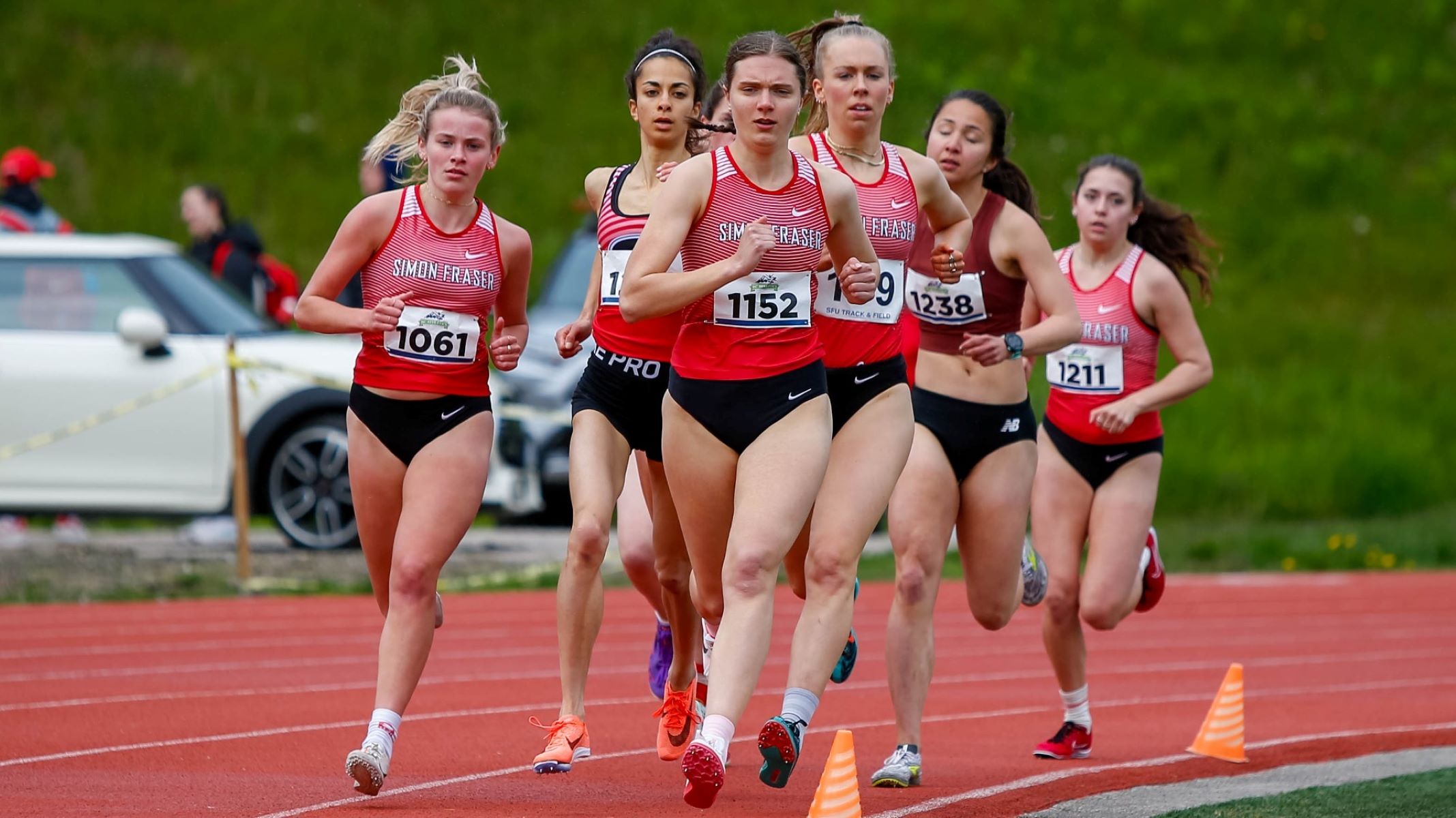Home>Misc>Featured>What Does The Cycle Of Success Lead To In Track And Field


Featured
What Does The Cycle Of Success Lead To In Track And Field
Modified: January 2, 2024
Discover the featured track and field events that lead to the cycle of success with our comprehensive guide. Achieve greatness in your athletic journey.
Introduction
Track and field is a sport that requires a unique combination of skill, athleticism, and mental fortitude. Athletes who participate in track and field events face numerous challenges, from intense physical training to the pressure of competition. However, the pursuit of success in this sport can lead to remarkable personal growth and accomplishment.
Success in track and field isn’t just about winning races or breaking records; it’s a journey that involves setting goals, developing the right mindset, consistently putting in the work, and overcoming obstacles along the way. It’s a cycle of continuous improvement that leads to higher levels of achievement.
Throughout this article, we will explore the cycle of success in track and field, examining the key components that athletes must focus on to reach their full potential. From goal setting to teamwork, from resilience to adaptation, each step in the cycle contributes to an athlete’s overall success.
Whether you’re a beginner just starting out in track and field or an experienced athlete looking to take your performance to the next level, understanding and embracing this cycle of success can help you navigate the challenges and achieve your goals.
The Importance of Success in Track and Field
Success in track and field holds a significant importance for athletes, coaches, and fans alike. It goes beyond the thrill of winning medals and breaking records. Here are some reasons why success in track and field is highly valued:
- Validation of Hard Work and Dedication: Achieving success in track and field is a testament to the countless hours of training, discipline, and sacrifices athletes put in. It validates their hard work and serves as a motivation to continue striving for greatness.
- Building Self-Confidence: Success in track and field boosts an athlete’s confidence. Breaking personal records or winning races not only demonstrates their physical abilities but also instills a belief in their own capabilities, both on and off the track.
- Inspiring Others: Successful track and field athletes serve as role models for aspiring athletes. Their achievements inspire others to set high goals, work hard, and pursue excellence in their own athletic endeavors.
- Opportunities for Advancement: Success in track and field opens doors to various opportunities, such as college scholarships, sponsorship deals, and professional contracts. It provides athletes with a platform to elevate their athletic careers and pursue their dreams.
- Physical and Mental Health Benefits: Engaging in track and field and achieving success in the sport offer numerous health benefits. Regular training helps to improve cardiovascular fitness, strength, and endurance. Additionally, the mental resilience developed through the pursuit of success contributes to overall mental well-being.
It is important to note that success in track and field is not solely determined by winning or achieving external accolades. Each individual defines their own version of success, whether it’s improving their personal best, overcoming challenges, or simply finding joy and fulfillment in the sport.
By recognizing the value and importance of success in track and field, athletes can fuel their motivation, set meaningful goals, and embark on a journey of growth and achievement.
The Cycle of Success in Track and Field
In track and field, success is not a one-time event but rather a continuous cycle of growth and improvement. This cycle encompasses various key components that athletes need to focus on to achieve lasting success. Let’s explore each step of the cycle:
- Set Goals: The first step in the cycle of success is setting clear and specific goals. Athletes need to define what they want to achieve, whether it’s improving their personal best, qualifying for a championship meet, or reaching a certain skill level. Setting goals provides direction and motivation.
- Establish the Right Mindset: A positive and determined mindset is crucial for success in track and field. Athletes need to cultivate mental toughness, believe in their abilities, and maintain a resilient attitude when facing challenges or setbacks.
- Develop Proper Training Methods: Success in track and field requires a well-designed training plan tailored to an athlete’s specific needs. This includes a combination of endurance, speed, strength, and technique training to enhance performance and prevent injuries.
- Consistency and Discipline: Consistency is key in track and field. Athletes must commit to a regular training schedule, follow through with their workouts, and maintain discipline in their diet and lifestyle choices. A consistent approach lays the foundation for long-term success.
- Experience and Knowledge: Learning from past experiences and continuously expanding knowledge about the sport are essential aspects of the cycle of success. Athletes can gain insights through their own performance analysis, studying competitors, and seeking guidance from coaches and mentors.
- Mentoring and Coaching: Guidance from experienced coaches and mentors plays a critical role in an athlete’s progress. They provide valuable feedback, technical expertise, and emotional support, helping athletes reach their full potential.
- Teamwork and Support: Track and field may seem like an individual sport, but teamwork and support from training partners, teammates, and the wider athletics community are fundamental. Having a strong support system fosters motivation, accountability, and a sense of camaraderie.
- Overcoming Challenges and Failures: Challenges and failures are inevitable in any athletic journey. Successful athletes embrace these obstacles as opportunities for growth, learn from their mistakes, and use setbacks as fuel to bounce back stronger.
- Adaptation and Improvement: The ability to adapt to different training methods, adjust strategies, and embrace new technologies and techniques is essential in the cycle of success. Athletes must continually seek ways to improve and refine their skills to stay competitive.
- Achieving Success: The final step in the cycle is the realization of success. It could be achieving personal bests, winning championships, or earning recognition for one’s accomplishments. Celebration and acknowledgement of success provide motivation and serve as milestones in the ongoing journey.
Each step in the cycle of success is interconnected and builds upon the previous one. This iterative process empowers athletes to continually raise the bar and push their limits, leading to sustained growth and achievement in track and field.
Set Goals
Setting goals is the critical first step in the cycle of success in track and field. It involves defining what an athlete wants to achieve, both in the short term and the long term. Effective goal-setting provides athletes with direction, focus, and motivation throughout their training and competition.
When setting goals, it’s essential to make them specific, measurable, attainable, relevant, and time-bound (SMART). Specific goals help athletes identify exactly what they want to accomplish. Measurable goals provide a quantifiable way to track progress. Attainable goals are realistic and within an athlete’s capabilities. Relevant goals align with an athlete’s overall vision and aspirations. Time-bound goals have a clear deadline or timeframe attached to them.
Some common types of goals in track and field include improving personal bests, qualifying for specific competitions, and mastering specific techniques or skills. Athletes may also set process-oriented goals, such as improving their training consistency or developing mental resilience.
Goals should be challenging yet realistic, pushing athletes to strive for continuous improvement. They should be broken down into short-term and long-term goals, allowing for progress markers along the way. Short-term goals provide smaller steps and milestones to achieve, while long-term goals provide a bigger picture and guide an athlete’s overall trajectory.
To ensure goal-setting success, athletes should write down their goals and review them regularly. This helps maintain focus and provides a constant reminder of what they’re working towards. Additionally, sharing goals with coaches, teammates, or training partners can provide accountability and support.
It’s important to note that goals can and should be adjusted as needed. As athletes progress and achieve certain milestones, they may need to set new goals to continue their growth. Reflecting on goal progress is crucial to identify areas for improvement and to make necessary adaptations to training methods or approaches.
Setting goals in track and field is not just about reaching the destination but also about the journey. It provides athletes with a clear purpose, motivates them to put in consistent effort, and helps them navigate challenges and setbacks along the way. By setting clear and meaningful goals, athletes lay the foundation for success in track and field.
Establish the Right Mindset
Establishing the right mindset is crucial for success in track and field. The mental aspect of the sport is just as important as the physical, and having a positive and determined mindset can make all the difference in an athlete’s performance.
Athletes must cultivate a mindset of resilience, belief, and growth. This involves developing the ability to overcome challenges, bounce back from setbacks, and maintain a strong belief in their abilities and potential.
One key aspect of the right mindset is embracing a growth mindset. This means viewing challenges as opportunities for learning and growth rather than as obstacles. Athletes with a growth mindset see setbacks as valuable feedback and use them to improve and refine their skills.
In addition to a growth mindset, visualization techniques can also help athletes establish the right mindset. By visualizing themselves performing at their best, athletes can enhance their confidence, focus, and mental preparation. Visualization can be done before competitions, during training sessions, or as part of a regular mental imagery practice.
Another important aspect of mindset in track and field is the ability to stay present and focused. Distractions can hinder performance and take away from an athlete’s ability to fully engage in the task at hand. Developing mindfulness techniques can help athletes maintain focus, block out distractions, and stay present in the moment.
Furthermore, setting and focusing on process-oriented goals rather than solely outcome-based goals can help athletes establish a healthy mindset. Instead of solely focusing on winning, athletes can redirect their attention to the process of training, improving technique, and giving their best effort. This shift in mindset allows athletes to enjoy the journey and find fulfillment in the daily progress they make.
Lastly, maintaining a positive and supportive inner dialogue is crucial in establishing the right mindset. Negative self-talk and self-doubt can be detrimental to performance and hinder an athlete’s belief in themselves. Building a positive internal dialogue through affirmations, positive self-talk, and self-encouragement can help athletes build confidence and resilience.
Establishing the right mindset in track and field is an ongoing process. It requires practice, self-awareness, and a willingness to challenge limiting beliefs. By cultivating a positive mindset, athletes can overcome obstacles, handle pressure more effectively, and unlock their full potential in the sport.
Develop Proper Training Methods
Developing proper training methods is essential for success in track and field. It involves finding the right balance of endurance, speed, strength, and technique training to improve performance and prevent injuries.
Each track and field event requires specific training techniques and exercises tailored to the demands of the discipline. Long-distance runners focus on building endurance through long runs and interval training. Sprinters work on explosive speed and power with short bursts of intense sprinting. Jumpers and throwers develop strength and explosive power through weightlifting exercises.
It’s important for athletes to work with experienced coaches who can design a training program specific to their event and individual needs. Coaches can provide guidance on proper form and technique, help set realistic training goals, and assess an athlete’s progress.
A well-rounded training program in track and field should include a combination of cardiovascular exercises, strength training, plyometrics, flexibility exercises, and skill-specific drills. The training program should be progressive, gradually increasing intensity and volume over time to avoid overtraining and reduce the risk of injuries.
In addition to physical training, athletes should also prioritize recovery and rest as part of their training methods. Adequate rest and proper nutrition are vital for muscle repair, injury prevention, and overall performance improvement. This may involve incorporating rest days into the training schedule, practicing active recovery techniques, and fueling the body with nutritious food.
Tracking and monitoring progress is also important for developing proper training methods. Athletes can use tools such as training logs, heart rate monitors, and performance data to assess their performance, identify areas for improvement, and make necessary adjustments to their training program.
Lastly, staying up-to-date with advancements in sports science, technology, and training methodologies is crucial for optimizing training methods in track and field. Athletes should be open to experimenting with new training techniques, equipment, and recovery modalities to stay on the cutting edge of their sport.
Developing proper training methods in track and field requires a combination of knowledge, experience, and adaptability. By following a well-structured training program, working closely with qualified coaches, and making adjustments as needed, athletes can maximize their potential and thrive in their respective events.
Consistency and Discipline
Consistency and discipline are key factors that contribute to success in track and field. They are the building blocks upon which athletes can develop their skills, improve performance, and achieve their goals.
Consistency involves committing to a regular and structured training schedule. It means showing up consistently, day in and day out, and putting in the necessary work to progress. Athletes who are consistent in their training develop a solid foundation of skills, endurance, and mental resilience.
Discipline is the ability to adhere to the training program, even when motivation may be lacking or external factors may try to distract from the goal. It requires athletes to stay focused and committed, even when faced with obstacles or setbacks. Discipline enables athletes to make the right choices in terms of training, nutrition, rest, and sacrificing short-term temptations for long-term success.
Consistency and discipline go hand in hand. Consistency ensures that athletes are consistently putting in the effort and staying on track with their training goals. Discipline ensures that athletes have the focus and determination to follow through with their commitments, even in the face of challenges.
Being consistent and disciplined requires developing healthy habits and routines. This includes establishing a regular training schedule, prioritizing rest and recovery, following a balanced and nutritious diet, and creating a conducive training environment. Creating a routine helps to eliminate decision fatigue and make the necessary actions automatic.
Accountability is also crucial in maintaining consistency and discipline. Athletes can seek accountability through training partners, coaches, or even online communities. Sharing goals and progress with others can help athletes stay committed and motivated throughout their journey.
Additionally, mindset plays a significant role in staying consistent and disciplined. A positive and determined mindset helps athletes overcome mental barriers, handle setbacks, and remain focused on the long-term goals. By staying focused on the ultimate objective, athletes can stay motivated and maintain the discipline required to push through challenges.
It’s important to remember that consistency and discipline are not about perfection. There will be days when motivation is low, life gets in the way, or unexpected circumstances arise. However, it’s in these moments that true discipline and consistency shine. Athletes who can adapt and persevere during these times ultimately come out stronger in the end.
In track and field, consistent and disciplined athletes gain a competitive edge. They foster habits that lead to continuous improvement, allowing them to reach new levels of performance and achieve their desired results.
Experience and Knowledge
Experience and knowledge play a crucial role in the pursuit of success in track and field. Athletes who actively seek to acquire knowledge about their sport and leverage their experiences gain a competitive edge and set themselves up for long-term growth.
Experience in track and field comes through actively participating in competitions, training sessions, and off-season activities. Each experience provides valuable lessons and insights that athletes can learn from and apply to their future performances.
By reflecting on past experiences, athletes can identify areas for improvement, refine their strategies, and make necessary adjustments to their training or competition approach. Experience helps athletes develop a deeper understanding of their strengths, weaknesses, and optimal race strategies.
Knowledge is equally important in the pursuit of success. This includes understanding the principles of training, biomechanics, nutrition, injury prevention, and other factors related to performance in track and field. Athletes who seek knowledge gain a better grasp of what it takes to excel in their chosen discipline.
Athletes can expand their knowledge through various means, including reading books and articles, attending seminars and workshops, engaging in discussions with coaches and experts, and learning from experienced athletes in their event. Seeking guidance from knowledgeable sources allows athletes to tap into a wealth of information and avoid common pitfalls.
The combination of experience and knowledge allows athletes to make more informed decisions about their training, technique, and overall approach to the sport. This helps athletes identify areas of improvement and make the necessary adjustments to continually progress.
Additionally, experience and knowledge contribute to the mental aspect of performance in track and field. Athletes who have been in various competitive situations develop mental toughness and the ability to handle pressure. They have a deeper understanding of how to mentally prepare for races, cope with setbacks, and stay focused on their goals.
Furthermore, experienced athletes often become mentors and role models for younger or less experienced teammates. Sharing their knowledge and experiences can inspire and guide others on their own journey to success, creating a positive and supportive team environment.
It’s important for athletes to embrace the continuous process of learning and to remain open to new experiences. By seeking out experiences and knowledge, athletes can continually grow and improve, ultimately reaching new heights of success in track and field.
Mentoring and Coaching
Mentoring and coaching are invaluable resources in the journey towards success in track and field. The guidance, support, and expertise provided by mentors and coaches can make a significant difference in an athlete’s development and performance.
Mentors and coaches serve as role models and sources of inspiration for athletes. They have the experience, knowledge, and understanding of the sport to provide insightful guidance and help athletes navigate the complexities of track and field.
A mentor can be someone who has excelled in the sport or has a deep understanding of the specific event. They offer support, guidance, and advice, helping athletes set goals, develop strategies, and overcome challenges. Mentors provide a unique perspective, fueled by their own experiences and insights.
Coaches play a critical role in an athlete’s development. They design and implement training programs, provide technical guidance, and offer feedback to improve performance. A good coach understands an athlete’s strengths and weaknesses, tailoring training to maximize potential and address specific areas for improvement.
Effective mentoring and coaching relationships are built on trust, open communication, and mutual respect. Coaches and mentors provide encouragement and motivation during both the highs and lows of an athlete’s journey. They offer support not only in the technical aspects of track and field but also in the mental and emotional aspects of the sport.
Mentors and coaches also act as accountability partners, ensuring that athletes stay committed to their training program and follow through with their goals. They provide structure and guidance, helping athletes stay focused and motivated throughout their season.
Another aspect of mentoring and coaching in track and field is the development of a team culture. Coaches and mentors foster an environment of camaraderie, teamwork, and support. They encourage athletes to uplift each other, celebrate successes, and learn from setbacks together. This team dynamic motivates athletes to strive for excellence and creates a sense of belonging.
It’s important for athletes to actively seek out mentors and coaches who align with their goals, values, and training philosophy. Building a strong mentoring and coaching relationship requires open communication, a willingness to listen and learn, and a shared commitment to personal growth and development.
With the guidance of mentors and coaches, athletes can accelerate their progress, push past limitations, and achieve their full potential in track and field.
Teamwork and Support
Teamwork and support are essential elements in the pursuit of success in track and field. While track and field may be seen as an individual sport, the power of a supportive team environment and the collective effort of teammates cannot be underestimated.
Being part of a team in track and field provides athletes with a sense of belonging, camaraderie, and shared commitment to excellence. Teammates push and motivate each other to reach new heights, creating a positive competitive atmosphere.
Teamwork in track and field involves collaborating with teammates, training partners, coaches, and support staff to collectively work towards common goals. Athletes benefit from the shared knowledge, experience, and support of those around them.
Training with a team allows athletes to push each other during workouts, provide feedback, and offer support during challenging training sessions. The support and encouragement of teammates can be a powerful motivator to achieve personal bests and overcome obstacles.
In addition to on-the-field support, teammates provide emotional support and a network of individuals who understand the unique challenges of the sport. They become a support system during both successes and failures, helping athletes navigate the highs and lows of their athletic journey.
Support from coaches is also critical for success in track and field. Coaches provide guidance, expertise, and technical instruction to help athletes improve their skills and reach their potential. They create a training environment that fosters teamwork, communication, and a sense of shared purpose.
Outside of the immediate team, athletes often receive support from their families, friends, and the wider track and field community. The encouragement and belief in an athlete’s abilities from their support network can be instrumental in staying motivated and overcoming challenges.
Successful track and field athletes understand the importance of giving back to their team and community. They provide support and encouragement to their teammates, creating a culture of mutual respect and support. Sharing knowledge, experiences, and celebrating each other’s successes further reinforces the sense of teamwork and camaraderie.
By fostering teamwork and building a supportive network, athletes develop a strong foundation for success. They see themselves not only as individuals but also as part of a larger collective striving for excellence in track and field.
Overcoming Challenges and Failures
In the journey towards success in track and field, athletes are bound to face various challenges and experience failures. How athletes navigate these obstacles and setbacks can significantly impact their growth and ultimately lead to success.
Challenges in track and field can come in many forms, including injuries, performance plateaus, mental barriers, and intense competition. These challenges test an athlete’s physical and mental resilience, requiring them to dig deep and find the determination to persevere.
Failures, such as not achieving a desired result in a competition or falling short of a goal, can be disheartening. However, successful athletes view failures as learning opportunities rather than as defeats. They understand that setbacks and failures are an inherent part of the journey to success.
To overcome challenges and failures in track and field, athletes should adopt a growth mindset. This mindset allows them to see challenges and setbacks as opportunities for growth, learning, and improvement. They use setbacks as stepping stones to come back stronger and more determined.
Resilience is another crucial quality for overcoming challenges and failures. Resilient athletes are able to bounce back from setbacks, adapt to change, and maintain a positive outlook. They maintain focus on their long-term goals, even when faced with short-term setbacks.
Having a strong support system is instrumental in overcoming challenges and failures. Teammates, coaches, mentors, and the wider track and field community can provide encouragement, guidance, and a listening ear. Seeking support from others helps athletes gain perspective, draw strength, and find solutions to overcome obstacles.
Reflection and analysis are also valuable tools for overcoming challenges and failures. Athletes can examine the factors that contributed to the challenge or failure and identify areas for improvement. This self-reflection allows for adjustments in training, technique, or mental strategies, leading to growth and progress.
Positivity and a solution-oriented mindset are important when facing challenges and failures. Instead of dwelling on the negative aspects, successful athletes focus on finding solutions and taking proactive steps to overcome obstacles. This positive outlook allows them to maintain motivation and move forward.
It’s important to remember that challenges and failures are not indicators of an athlete’s worth or potential. They are simply opportunities for growth and improvement. By embracing challenges, staying resilient, seeking support, and learning from failures, athletes can overcome obstacles on their path to success in track and field.
Adaptation and Improvement
In the constantly evolving world of track and field, athletes must be adaptable and continuously seek ways to improve. The ability to adapt to changing circumstances, refine training methods, and strive for personal growth is essential for long-term success.
Track and field events are influenced by various factors, including advancements in sports science, rule changes, and new techniques. Athletes who embrace change and adapt their training methods accordingly have a competitive advantage.
Adaptation involves being open to new ideas, techniques, and technologies that can enhance performance. It requires athletes to stay current with the latest research, attend workshops and seminars, and seek insights from experts in the field.
An important aspect of adaptation is the willingness to modify training plans and strategies when needed. This could involve adjusting workout routines, incorporating new drills, or even seeking a different coaching approach. Adaptation allows athletes to optimize their training and stay ahead of the competition.
Continuous improvement is a fundamental aspect of success in track and field. Athletes must constantly seek ways to enhance their skills, techniques, and physical conditioning. This involves analyzing their performance, identifying areas for improvement, and setting goals to address those areas.
Regular performance evaluations, self-assessment, and seeking feedback from coaches and mentors provide insights into areas that need improvement. This feedback helps athletes make the necessary adjustments to refine their training and refine their strategies.
Improvement is not limited to physical aspects. Mental training and emotional resilience are also areas that can lead to significant progress in track and field. Athletes can incorporate techniques such as visualization, meditation, and positive self-talk to enhance mental focus and stay mentally strong during competition.
Adaptation and improvement also involve recognizing and learning from mistakes and failures. Successful athletes view setbacks as opportunities for growth rather than as defeats. By embracing these learning experiences, athletes can make necessary adjustments and improve their future performance.
It is important for athletes to approach adaptation and improvement with a growth mindset. Embracing a mindset of continuous learning, seeking feedback, and being open to change allows athletes to unlock their full potential and reach new levels of success in track and field.
Achieving Success
Achieving success in track and field is the culmination of the entire cycle of growth, improvement, and dedication. It is the moment when athletes realize their goals, witness their hard work pay off, and experience the fulfillment of their efforts.
While success is highly individualized and can be defined differently by each athlete, there are common elements that contribute to achieving success in track and field.
First and foremost, success in track and field is anchored in the relentless pursuit of excellence. It requires setting high goals, maintaining a consistent and disciplined training regimen, and constantly seeking areas for improvement.
An integral part of achieving success is the ability to overcome challenges, setbacks, and failures along the way. Successful athletes view these obstacles as learning opportunities and use them as stepping stones to reach new heights.
Mentoring and coaching play a crucial role in an athlete’s journey towards success. The guidance, support, and knowledge imparted by mentors and coaches provide athletes with the tools and strategies to excel in their respective events.
Teamwork and support from teammates, coaches, and the wider track and field community create a positive and motivating environment. Athletes thrive in a supportive network and draw strength from the encouragement and camaraderie of those around them.
Adaptation and continuous improvement are also key in achieving success. Adapting to changing circumstances, refining training methods, and seeking new strategies to enhance performance allow athletes to stay ahead of the curve and compete at their best.
Ultimately, achieving success in track and field requires a combination of physical prowess, mental fortitude, and unwavering passion for the sport. It requires perseverance, determination, and the ability to remain focused on the ultimate goal, even in the face of adversity.
It is important to note that success in track and field extends beyond winning medals and breaking records. Success is also measured by personal growth, the development of character, and the lasting impact an athlete has on others.
Each athlete’s journey to success is unique, and the path may be filled with ups and downs. However, with a clear vision, unwavering dedication, and a commitment to the cycle of success, athletes can achieve their goals and experience the unparalleled satisfaction of success in track and field.
Conclusion
The pursuit of success in track and field is a multifaceted journey that involves setting goals, establishing the right mindset, developing proper training methods, and consistently pushing oneself to improve. It is a cycle of growth, adaptation, and refinement that leads to personal and athletic achievements.
Success in track and field goes far beyond winning races and breaking records. It encompasses personal growth, resilience, and the ability to overcome challenges and setbacks. It is fueled by the dedication, discipline, and passion of athletes who are committed to their craft.
Throughout the cycle of success, athletes rely on mentors, coaches, teammates, and a broader support network to provide guidance, inspiration, and encouragement. They leverage their experiences, seek knowledge, and adapt to ever-changing circumstances to continuously improve and achieve their goals.
In track and field, success is not measured solely by external recognition but also by the pursuit of personal excellence, the impact on others, and the lasting legacy an athlete leaves behind. It is an ongoing journey of self-discovery, growth, and the constant push to reach new levels of performance.
Whether you are a seasoned athlete or just taking your first steps in track and field, embracing the cycle of success can guide you towards reaching your full potential. By setting clear goals, cultivating a positive mindset, and continually adapting and improving, you can unlock the remarkable achievements that await you in this challenging and rewarding sport.









